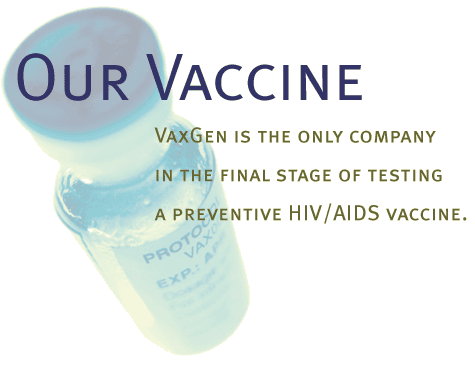|
|
U.S. Company Raises Hopes for AIDS Vaccine |
|
A preventive vaccine
against HIV / AIDS could be available by 2005 if results Early results from
Phase III trials of a preventive AIDS vaccine will not be available |
|
|
BEST HOPE TO CONTROL EPIDEMIC With 40 million
people living with HIV/AIDS and infection rates rising, a preventive
vaccine is considered the best hope to control Drugs have prolonged the lives of sufferers in the West but few in the developing world have access to them. It is doubtful that
the first preventive vaccine will be 100 percent effective against the
virus, but experts believe even 30 VaxGen's AIDS
vaccine works by inducing the immune system to produce antibodies that attach to the gp120 protein on There are five major
subtypes of HIV in different areas of the world. In Thailand there is just one subtype but |

|
AIDSVAX - Description: AIDSVAX is the trade name for all formulations of
VaxGenís preventive HIV/AIDS vaccine candidates, two of which
Like nearly every licensed vaccine, AIDSVAX induces the immune system to
produce antibodies. These antibodies are Earlier vaccines used live or attenuated virus to
trigger an immune response. Because AIDSVAX induces antibodies HIV Infection Process Potential Protection Process The primary components of AIDSVAX are genetically
engineered proteins. These synthetic proteins are identical Manufacturing Process Chimpanzee Studies In the first test, the chimpanzees were vaccinated with a gp120
formulation designed to protect against one particular In the second test, the vaccinated chimps were challenged with an HIV
strain that was significantly different from the one |
|
|
HIV / AIDS: Description Of The Virus HIV is the virus
that causes AIDS. Like other viruses, HIV multiplies by entering and |
|
HIV is spread through blood, semen, breast milk and vaginal fluid,
including menstrual fluid. People who contract HIV HIV is also unusual because it is virtually 100% fatal. In the vast
majority of cases worldwide, Each HIV particle is composed of an outer layer studded with proteins
known as gp120, and a core Once inside, the HIV virus fuses with the cellís genetic machinery
and begins to multiply, producing thousands of progeny. HIV Variation Like any virus, HIV has mutated to form distinct subtypes. Today,
there are five major subtypes A, B, C, D, and E One would assume that this mutation process would continue
indefinitely. But this has not been the case. |